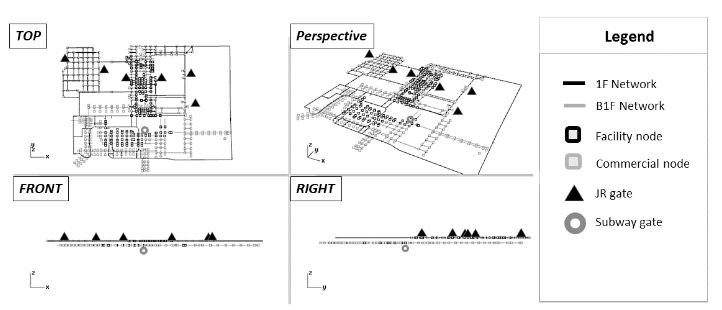Identifying the Arrangementof Activities of Corridor Spaces in Transit Station
DOI:
https://doi.org/10.56261/built.v10.117031Keywords:
Corridor space, Transit Oriented Development (TOD), Transit station, Transit connectivity, Urban spatial structureAbstract
Public transit passengers use corridor spaces in transit stations to access transit services. These transit stations are designed for multi-modal transportation purposes, as space which connects each mode of transit between stations or planned areas plays an important role in the movement of passengers from one mode to another. The characteristics of corridor space vary according to the surrounding activities which shape their diverse functions and the time taken by passengers to connect between transit modes. An exploratory analysis was conducted to determine the basic properties and functions of corridor spaces in Hakata station, Fukuoka Prefecture, Japan with regard to the availability of transit services and activities in station building area. Commercial and facilities activities were selected to identify the characteristics of corridor spaces. A spatial analysis of activities located along the corridor spaces and architectural performance was also conducted using the betweenness analysis in order to identify the interaction between subjected activities and archtecture space in station building. Each type also contained specific functions which defined its spatial performance regarding transit mode connection behavior. Results suggested that the arrangement of activities in corridor spaces influenced passenger route-choice accessibility.
Downloads
References
Akiyama, T., Kamata, M., Wahira, Y., & Fujii, N. (2001). Vehicle accessibility in Japan today and the outlook for the future. IATSS Research, 25(1), 42-50.
Banister, D., & Thurstain-Goodwin, M. (2011). Quantification of the non-transport benefits resulting from rail investment. Journal of Transport Geography 19, 212-223.
Carlton, I. (2007). Histories of Transit-Oriented Development: Perspectives on the development of the TOD Concept. California: University of California, Berkeley.
Ching, F. (2007). Architecture form, space, and order (3 ed.). John Wiley & Sons, Inc.
Dial, R. B., & Bunyan, R. E. (1968). Public transit planning system. Socio-Economic Planning Sciences, 1(3), 345-362.
Glick, J. (2009). The space between buildings: Activating downtown’s open spaces: DDLP 2009.
Denver.Kido, E. M. (2015). Railway station - The borderline between architecture and structure. Japan: CTI Engineering Co., Ltd.
Morimoto, A. (2015). Transportation and land use. In K. Doi, Traffic and Safety Sciences: Interdisciplinary Wisdom of IATSS (pp. 22-30). Japan: The International Association of Traffic and Safety Sciences (IATSS).
Papa, E., & Bertolini, L. (2015). Accessibility and Transit-Oriented Development in European metropolitan areas. Journal of Transport Geography 47, 70-83.
Papa, E., Pagliara, F., & Bertolini, L. (2008). Rail system development and urban transformations: Towards a spatial decision support system. In F. Bruinsma, E. Pels, H. Priemus, P. Rietveld, & B. V. Wee, Railway Development Impacts on Urban Dynamics (pp. 337-358). Physica- Verlag: A Springer Company.
Ratner, K. A., & Goetz, A. R. (2013). The reshaping of land use and urban form in Denver through transit-oriented development. Cities 30, 31-46.
Rodrıguez, D. A., & Joo, J. (2004). The relationship between non-motorized mode choice and the local physical environment. Transportation Research Part D 9, 151-173.
Sevtsuk, A., & Kalvo, R. (2015). Urban Network Analysis Toolbox for Rhinoceros 3D: Help version 5.10.10.3 R5RS10. Singapore: Singapore University of Technology & Design in collaboration with MIT.
Singh, Y. J., Lukman, A., Flacke, J., Zuidgeest, M., & Maarseveen, Van, M.F.A.M. (2017). Measuring TOD around transit nodes - Towards TOD policy. Transport Policy 56, 96-111.
Thomas, M. (2016). Research for tran committee – The Japanese transport system. European Parliament.
Venter, C. (2016). Assessing the potential of bus rapid transit-led network restructuring for enhancing affordable access to employment: The case of Johannesburg’s Corridors of Freedom. Research in Transportation Economics 59, 441-449.
Zhuang, X., & Zhao, S. (2014). Effects of land and building usage on population, land price and passengers in station areas: A case study in Fukuoka, Japan. Frontiers of Architectural Research, 3(2), 199-212.

Downloads
Published
How to Cite
Issue
Section
License
Copyright (c) 2017 International Journal of Building, Urban, Interior and Landscape Technology (BUILT)

This work is licensed under a Creative Commons Attribution-NonCommercial-NoDerivatives 4.0 International License.











